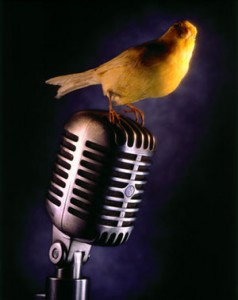 I was working on a long voiceover recording job last week. After it was all recorded, I began the long process of editing it for the client. That involved not only optimizing the volume and minimizing the noise, but also creating 27 separate files. Things were progressing nicely, but then I heard an odd sound behind the voice at one point. You can probably guess by the title of the post what that sound was. Sigh.
I was working on a long voiceover recording job last week. After it was all recorded, I began the long process of editing it for the client. That involved not only optimizing the volume and minimizing the noise, but also creating 27 separate files. Things were progressing nicely, but then I heard an odd sound behind the voice at one point. You can probably guess by the title of the post what that sound was. Sigh.
Keep in mind that most voiceover jobs do not involve multitrack recording. That is to say, there is only one single track of audio being recorded. So if you hear a bird’s hoot AND your voice together on the recording, you can’t just “delete” the bird sound. In multitrack recording – such as you would use for most music recording – you purposely put different sounds on their own tracks so you can adjust the volume of each sound until it all mixes together nicely. THEN you render (mix down) the result to a single file. But I did not have the luxury of simply turning down the bird hoot. How in the world do I get rid of it?
OK, sure. I could just re-record that part when the bird is NOT outside my window. But that smacks of effort. I like to do things the easy way if I can. Yes, you may substitute the word “lazy” into that last sentence:-P. Anyway, there are some audio editing tools that you can use to reduce (or even eliminate) one type of sound, while leaving the desired audio alone. One of the best of these tools is EQ (short for “equalization”).
If the undesired audio has a much different frequency than the desired audio, then EQ can help filter out what you don’t want to hear. Sadly, this is not always the case. Sometimes, in order to remove one sound, you end up removing some or most of the sound you want to keep. But in this case, I was in luck.
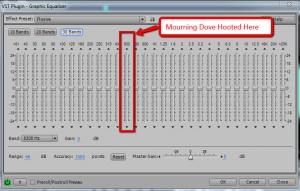
One other piece of good fortune was that a small amount of the dove noise was sounding during a section when the voice was not talking. It wasn’t enough to sample into a noise-reduction effect (unfortunately – because that is another good way to filter out the bad while leaving the good). So I highlighted the small bit of audio that had ONLY the mourning dove hoot in it. Then I opened the Graphic Equalizer tool in Adobe Audition (I still use version 3, but Audition is also part of Adobe CC – Adobe Audition CC [Digital Membership]). While listening to the hooting on a loop, I just started dragging down sliders (each slider is set to a specific frequency). If it didn’t silence the bird, I reset the sliders and tried the next one. It only took me about 10 seconds to locate the right frequency, which happened to be 500 Hz.
Awesome. Now that I knew that this particular mourning dove hooted at 500 Hz, I went back to the audio with both the voice AND the bird hooting in it, and highlighted that section. Then I just opened the Graphic Equalizer and started moving the slider at 500 Hz down, which turns down the volume at just that frequency. Now voices also produce sound at 500 Hz, so it I turned things down too much, the voice would also be affected. But in this case, by the time I moved the slider down enough to get rid of the dove, the voice still sounded fine. It probably helped that it was a female voice.
And the bird was gone! the entire process took about 60 seconds, which is a lot less time than it would have taken me to re-record the voice.
So the next time you have a bird outside your window threatening to ruin your recording session, remember this method. It might save you time and money. Of course, you could always build you own vocal isolation booth to record in. But that’s another topic altogether.
Recording Tips and Techniques
Folders In Reaper Instead Of Submix Busses
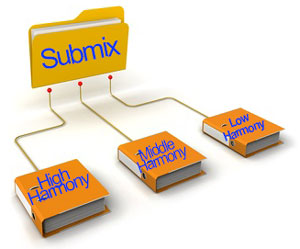 Wow! Even the title of this post started to make my brain seize up before I was even done writing it. The phrase “bored already” comes to mind.
Wow! Even the title of this post started to make my brain seize up before I was even done writing it. The phrase “bored already” comes to mind.
But I left it that way because folks who have done lots of recording before will understand what a submix bus (sometimes – even by me, depending in part on how much caffeine I’ve had – spelled “buss“) is.
If you don’t know what it is, see my article What is a Buss in Audio Recording?
OK, now I expect everyone to know what a submix bus is. You DID read your assignment didn’t you? I thought so. In most multitrack audio software programs (usually called digital audio workstations, or DAWs for short), if you want a submix (like the example of “one track to rule all the harmony tracks,” remember? From your reading?), you first have to create a special kind of track – a bus.
Then for each of the tracks whose audio you want inside the submix, you have to disable the “sends” going to the master bus. That’s because a bus track merely taps the audio on its source tracks – like creating a clone of it. It doesn’t stop those tracks from ALSO sending their audio to the master track. If your goal (as it often is with a submix) is to be able to control the volume of ALL the tracks in the submix group (like all the harmonies, say) with just a single knob/slider (the one on the submix bus track), then ALL of the audio from each of the original tracks needs to be routed through the submix track. Otherwise (I’m going back to the clone simile here), you could make the harmony clones be quiet by turning down the volume on the harmony submix track. But the originals – the “not clones” – are still yapping away, making all kinds of loud harmony-type sounds. Your submix track can’t control the originals! So you must destroy the originals (Insert dramatic music here) by disabling those “sends” headed for the master bus.
Enter The Track Folders
In Reaper – my favorite DAW – they have something called track Folders. They make it soooooo (is that enough “Os”?) easy to create a submix. Here is how you do it. Don’t look away because you might miss it (it’s THAT quick and easy)!
- Insert a new track (no need to worry about what KIND of track or anything) above your harmony tracks.
- Click on the little folder icon on the right side of the new track’s control panel.
- Click the folder icon of the last harmony track twice. Done!
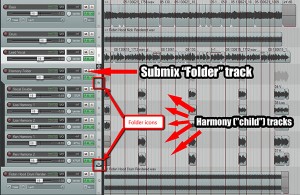
It took longer to type that than to actually do it. Assuming you have the correct mix (relative volumes) of the harmony parts against each other, all you have to do to control EVERY harmony in the folder track – put on reverb, turn them up or down in volume, compress them, etc. – is do it to that top track.
As I mentioned above, the tracks that get put into a folder are shown as indented (see the picture on the right), and are considered “child” tracks in the folder. The folder track at the top is the controlling or “parent” track for the submix created by the folder.
Using folders in Reaper is a HUGE time saver, and the best way to create a submix that I know of.
By the way, you can still do everything in Reaper “old school,” like creating “sends” from each harmony track and directing them to a new track that you call a “bus,” etc. if you want to. Maybe you have some special need for doing things the hard way, or maybe you want to teach someone how it used to be done in the old days. Some folks may want to do it this way for a very specific and unusual effect or something. But as far as I’m concerned, folders are the way to go!
Getting The Vocal To Blend Well In The Mix
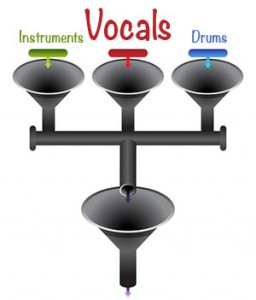 A friend sent me a private message on Facebook asking me about a recording problem he was having. He had recorded the music for a song, and that sounded great. Then he went ahead and recorded the vocal track, and that, by itself, sounded pretty decent too. However, he reported that the vocal was too up front in the mix. It didn’t blend in with the music, so they didn’t sound like a cohesive performance. He asked me if I had any ideas for getting the vocal to blend in better with the music. It turns out that I do:-P. Below is the advice I gave him:
A friend sent me a private message on Facebook asking me about a recording problem he was having. He had recorded the music for a song, and that sounded great. Then he went ahead and recorded the vocal track, and that, by itself, sounded pretty decent too. However, he reported that the vocal was too up front in the mix. It didn’t blend in with the music, so they didn’t sound like a cohesive performance. He asked me if I had any ideas for getting the vocal to blend in better with the music. It turns out that I do:-P. Below is the advice I gave him:
My Reply
Hi Ric! Yes, I do have a couple of ideas for you to try. The standard answer is to add reverb. You don’t have to add much to make it seem a bit further back in the mix. In fact sometimes you can get the “pushing further back” effect with so little reverb that you can’t really hear the verb in the mix. If you solo the vocal, you can hear it, but when all tracks are playing, the effect is simply to make the vocal seem a bit further away.
However, as with anything, the best way is a bit more involved, doing several things, but doing them in small doses, so that it’s the combination of several small things that create one subtle but significant effect (I’m always amazed at how similar cooking is to mixing). So here are some things to add to the act of applying just a pinch of reverb.
- Obviously, you can just turn the volume down on the vocal track. But then you might have trouble hearing the softest words/phrases.
- In that case, add a compression effect to the vocal track to even out the dynamics.
- Also, “ducking” is an awesome way to get the vocal to sink more into the mix. Here is an article I wrote about ducking: https://www.homebrewaudio.com/what-is-ducking-in-audio-recording/
- Then to fine-tune things, I recommend listening to the mix in the car and on an iPod/iPhone through headphones. Check for notes that pop out a little too loud or that are maybe too soft to hear, and make notes. Printing a lyric sheet and taking that with you to make these notes is highly recommended (yeah, I do this a lot:)). When you have all the notes, go back to your software and put a volume envelope on the vocal track. you can use that to quickly raise or lower just certain syllables or short words.
If you do just a smidgen of ALL of those things, you’ll probably be quite happy with the result.
Good luck!
We're Updating The Beginner's Audio Recording Tutorial Course
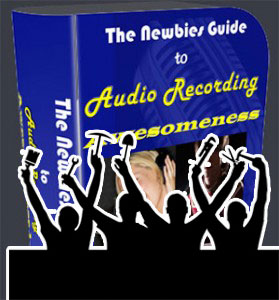 It’s been a few years since the initial tutorial course for audio recording beginners – The Newbies Guide To Audio Recording Awesomeness 1: The Basics With Audacity – was released. And as will happen, the software we teach you to use in that course, the free recording program called Audacity, has been updated several times in the interim. Today’s version, Audacity 2.0.5, has been so altered from the original that the videos in the course refer to menu items and audio effect locations that do not even exist any longer:-P. THAT is not very helpful, is it?
It’s been a few years since the initial tutorial course for audio recording beginners – The Newbies Guide To Audio Recording Awesomeness 1: The Basics With Audacity – was released. And as will happen, the software we teach you to use in that course, the free recording program called Audacity, has been updated several times in the interim. Today’s version, Audacity 2.0.5, has been so altered from the original that the videos in the course refer to menu items and audio effect locations that do not even exist any longer:-P. THAT is not very helpful, is it?
This first course is designed not only for people who have little or no experience recording audio, but also for people who have no budget for gear or software. I even recorded the audio narration for the first several lessons using that same budget – essentially somewhere around $0 to MAYBE $5 for a computer microphone that you plug into your computer’s sound card. I did that so you could get an idea how even the most basic no-frills, no cost home recording studio (your computer with free software) can sound.
[NOTE: The updated course was completed in Jan 2015! No need to buy anything again, if you already bought the course. The old videos have simply been replaced with the new ones. If you would like to purchase the course, visit the page here: The Newbies Guide To Audio Recording Awesomeness 1: The Basics With Audacity] So I am going through each video in each lesson and updating it so that it is consistent with the latest version of Audacity. This is pretty tedious work, so it will take another couple of weeks to complete the updated and revised edition. But I will publish the each new video as I complete them. That way you won’t have to wait until the entire course is updated before you start benefiting from the updates.
[Latest status: As of Dec 2nd 2014, Lessons 1 through 7 (15 videos) have been updated.]
I will keep you apprised of my progress as the milestones are met.
Cheers!
Ken
Pre-Roll And Punch Recording: Why I Don't Use Them
 Someone just asked about using pre-roll and punch in Reaper. If you don’t know what that means, it’s basically a way to insert just a bit of audio into an already-recorded track, usually to fix a mistake. In the old tape days, you had limited tracks to deal with, so it helped to correct a few seconds of audio by recording over it. But it was hard to hit Record and then Stop and have the replacement audio sound natural. And if you were recording by yourself, it was virtually impossible. So a bit of automation was invented that told the machine the “get ready” 5 (or 10 or whatever) seconds before the insertion point. That’s the “pre-roll.” The singer (or voiceover artist, or instrumentalist) would start singing/talking/playing. Then the machine would automatically start recording at the insertion point WHILE THE SINGER WAS ALREADY SINGING. Then it would stop recording at the end of the part you are replacing. That process is called “punching” or “punching in.”
Someone just asked about using pre-roll and punch in Reaper. If you don’t know what that means, it’s basically a way to insert just a bit of audio into an already-recorded track, usually to fix a mistake. In the old tape days, you had limited tracks to deal with, so it helped to correct a few seconds of audio by recording over it. But it was hard to hit Record and then Stop and have the replacement audio sound natural. And if you were recording by yourself, it was virtually impossible. So a bit of automation was invented that told the machine the “get ready” 5 (or 10 or whatever) seconds before the insertion point. That’s the “pre-roll.” The singer (or voiceover artist, or instrumentalist) would start singing/talking/playing. Then the machine would automatically start recording at the insertion point WHILE THE SINGER WAS ALREADY SINGING. Then it would stop recording at the end of the part you are replacing. That process is called “punching” or “punching in.”
But in the days of computer recording where you have unlimited tracks AND you can SEE your audio, as well as hear it, there is rarely a need to punch in on the same track. You might as well just open a new track under the original one and start playing/singing along just before the mistake while recording on the new track. Then you can “peel back the area of the original audio where the mistake is, trim the size of the replacement audio, and drag it up. You can do fine adjustments of the edges and length of sections, etc. after the fact until it’s perfect.
So I don’t punch in anymore. I do that thing I just described with a spare track. See our 2-part post for more details on how to do this here: Quickly Fix Audio Recording Mistakes by Overdubbing.